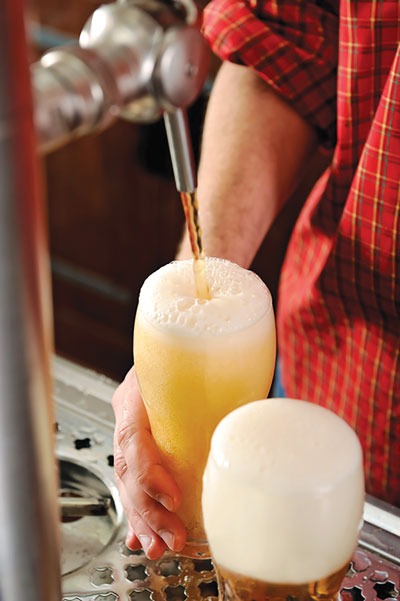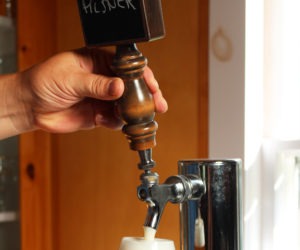Moving Beer: Advanced draft designs
Keeping a draft system running can be complex enough that it’s some people’s full-time job. The goal of any draft system is to dispense beer without changing the carbonation level designed into the product, at the correct serving temperature, with proper head, and very low beer loss. This becomes complex when you have different beers at different carbonation levels on the same tower. The largest system I have had responsibility for was 90 faucets. The most complex was a three-faucet tower, with one nitro draft line and two fully carbonated beers, where all the kegs were 75 ft. (23 m) away and three stories below the bar. I have also seen draft lines that are long enough that the line holds gallons (>4 L) of beer.

A standard carbonation chart will show you the relationship between CO2 pressure, temperature, and carbonation level. We will assume you are an advanced brewer and have used this chart before, and that your keg is carbonated to the carbonation level and temperature you would like to serve it, and the keg is at equilibrium with these conditions. Now, if we match the CO2 pressure and the temperature from the chart, we know we won’t change our carefully crafted CO2 volume. In a kegerator, the most common example of a short-draw system, we can simply connect the keg to the faucet using a short section of draft line, but our beer will likely flow out too fast and become a foamy mess when it enters the glass. When this occurs, many folks make the mistake of lowering the CO2 pressure to slow the flow. While this works in the short term, the CO2 pressure should match the chart for the carbonation level to stay the same over a longer time frame.
The solution to this problem is simple; increase the tubing length between the keg and the faucet in order to slow beer velocity and to balance the system. The friction between beer and tubing creates restriction, known as pressure drop, and we can do some simple math to calculate the length of tube required. If you look at the restriction chart (found below), you will see that different tubing material and diameter affect restriction. The sum of all the different components, namely the beer line length, reducers, and the faucet, sets the pressure drop of the whole system. In a kegerator you can simply add a length of 3⁄16-in. (5 mm) inside diameter (ID) tubing between the keg and the faucet to add sufficient pressure drop, slow the flow, and correct the problem.
The simplest way to calculate line length is to begin with your serving pressure. Let’s use 12 psi (83 kPa) in this example (2.55 volumes of carbon dioxide at 38 °F/3 °C), subtract 0.5 psi (3.4 kPa) — because we do want some flow coming out of the faucet — and divide it by the restriction. We’ve picked 3⁄16-in. (5 mm) ID vinyl tubing with 2.2 psi restriction per foot (50.6 kPa/m) for this example because this is the normal liquid line used to connect with U.S. beer taps (even systems with larger diameter beer lines use this section of “choker” for the final few feet and into the faucet). The hose length calculates out to be:
[(12 psi – 0.5 psi) ÷ 2.2 psi/ft.] = 5.2 ft.
Or
[(83 kPa – 3.4 kPa) ÷ 50.6 kPa/m] = 1.6 m
The restriction charts are not perfect and we’ll want more flow than a trickle. Starting long and cutting the tubing back is a perfect way to fine-tune the flow. If the pressure, temperature, or desired CO2 level changes, we can no longer use this length because the system balance is specific to these conditions.
This exercise brings up a practical question; how fast should the beer come out of the faucet? Bar systems are set up to minimize fill time and waste, and a great commercial install can fill a pint in less than 10 seconds. Time is money at a busy bar, but speed is not so critical at home where the most important factor is minimal uncontrolled gas break out and a proper pour. Although the standard beer faucet is usually open or closed, a skilled operator can play tricks with barely cracking the faucet open to pour foam, or vary how the beer enters the glass to prevent or cause gas breakout and foam formation.
Keep it Cold
One of the key things often overlooked when installing draft systems is that not all the beer in the system is at the same temperature. The most common problem is the beer faucet warms up, resulting in a foamy first pour. This initial foam causes nucleation sites in the glass, making the rest of the pint more likely to foam. One strategy is to dump the first ounce of beer if the faucet is warm after sitting unused for a while. Another general strategy is to install some sort of cooling system to keep the beer lines and the beer faucet cold; as it turns out there are several ways to cool a draft system.
The easiest way to keep a system cold is to install faucets on the side of a refrigerator or cooler. Most taproom breweries these days have this type of installation and you may have unknowingly seen these due to tile, metal, and/or wood façades installed on the exterior of coolers. While a convenient and functional design that does not take up bar space, these installations do require bartenders to turn away from the bar to serve a beer, adding time and making the interaction with patrons a bit different compared to pouring beer from faucets mounted on the bar.
Keeping a draft system running can be complex enough that it’s some people’s full-time job.
These cooler systems are easily made by boring a 15⁄16-in. (24 mm) hole through the cooler wall (or refrigerator door), installing a beer shank with 3⁄16-in. (5-mm) ID bore, attaching a 3⁄16-in. (5-mm) hose barb x beer nut adapter inside of the cooler (or buying a shank with a permanent barb installed), and connecting the beer faucet on the exterior of the cooler. You may be wondering how this system keeps the faucet cold. It turns out that the beer shank acts as a heat sink by conducting heat into the cooler where it is removed by the refrigeration system. In fact, a longer shank can work better than one sized to neatly fit the width of the door or wall panel. Although beer shanks installed in the walls of refrigerators and coolers are not perfect, they work pretty darn well.
Another common system is a kegerator with a draft tower mounted on top of the cooler. A draft tower is like the second story of a house, with the beer line extending from the first floor, through the second floor, and out of the roof of the house. In this analogy the first floor contains the air conditioner unit. Hot air rises and the air in a tower is not cold. This is why beer poured from a tower’s faucet can be fussy. Fortunately, cooler fans provide an inexpensive and effective fix to this physics problem. Fans can also be used in remote faucet systems where the tower is installed away from the kegs by installing a simple air conduit between the refrigerated space used for keg storage and your faucets. This type of system works best in towers that have two connection points to the bar top because cool air can be routed into one side and out the other, but also works well in towers with a single connection if the air hose is pushed towards the top of the tower.
If you are looking for the cat’s meow in cooling, the best method for remote systems is to use so-called python lines (also known as trunk lines), which contain beer lines and glycol lines (supply and return), tightly wrapped with a moisture-barrier adhesive foil, and all neatly bundled into a urethane insulation jacket. Pythons can be mounted to walls, ceilings, and run through underground conduits. And most pythons are connected to liquid-cooled draft towers that make these systems the best choice for remote installations. They also allow for the use of towers with aluminum blocks connected to the shank that give the faucet’s exterior that oh-so-cold and frosty look to let folks know that ice-cold beer is indeed on tap. The practical problem with these systems for the homebrewer is the cost of a glycol system, coupled with the more advanced and costly draft line package.
When Pressure Drop Exceeds Equilibrium Pressure
It’s not uncommon when moving beer long distances, especially when elevation changes are added into the mix, for the pressure drop of the system to exceed the equilibrium pressure of the beer(s) being poured. Most draft beer contains about 2.55 volumes of carbon dioxide with a corresponding pressure of 12 psi (83 kPa) at 38 °F (3 °C). OK, time for a little beer math that accounts for elevation changes. We need to know how much pressure is required to lift beer and we can use the fact that 2.3 ft. (0.7 m) of water column is equal to 1 psi of pressure (0.435 psi/ft. or 10 kPa/m) as a close approximation for most beer.
This means if beer is being moved from a basement cooler to a second-floor bar, about 20 ft. (6.1 m) for ease of discussion, the vertical rise is equal to ~8.7 psi or 60 kPa (20 ft. x 0.435 psi/ft. or 6.1 m x 10 kPa/m). Let’s consider this scenario with a system having 30 ft. (9.1 m) of 3⁄8-in. (9.5-mm) beer line with 0.2 psi/ft. (4.6 kPa/m) restriction and 1 ft. (0.3 m) of a 3⁄16-in. (5-mm) choker hose.
The total system drop = (20 ft. x 0.435 psi/ft.) + (30 ft. x 0.2 psi/ft.) + (1 ft. x 2.2 psi/ft.) = 16.9 psi
Or
The total system drop = (6.1 m x 10 kPa/m) + (9.1 m x 4.6 kPa/m) + (0.3 m x 50.6 kPa/m) = 118 kPa or 1.18 barr
This requires 17.4 psi (120 kPa) pressure at the inlet of the beer line to give us the ~0.5 psi (3.4 kPa) needed after the faucet. If we simply crank the keg pressure up to 17.4 psi (120 kPa), the beer will become over-carbonated because the equilibrium carbonation level at 38 °F (3 °C) and 17 psi (117 kPa) is 3.03 volume. The two most common ways to deal with this scenario are beer pumps and mixed-gas dispense (nitrogen + carbon dioxide).

Beer pumps and mixed-gas draft system are beyond the demands of most home systems, but for those with an interest in these topics, here is a bit of information. Electric and gas-operated beer pumps are commonly used in long-draw systems and are a handy way of separating beer carbonation concerns (gas pressure and beer temperature) from beer pumping because pumps add pressure to the system without affecting gas solubility. In this perspective, beer pumps are simple to use. The downside to pumps is that they have to be cleaned, maintained, and powered with compressed gas or electricity.
Another option for long-draw systems is the use of mixed gas blends that allow for higher applied pressures to be used to maintain normal carbonation levels. For example, a gas blend of 70% carbon dioxide and 30% nitrogen at 38 °F (3 °C) and 25 psi (172 kPa) is the correct equilibrium condition for beer with 2.55 volumes of carbon dioxide (online calculators are available from suppliers of gas blenders like McDantim). Aside from the cost of a blender or the added cost of purchasing pre-blended gas, mixed gas systems do not require additional hardware, like pumps, to maintain. And once a brewer is using blended gas and becomes familiar with the gas tables, producing nitro beers is pretty hard to resist.
Faucets Control the Flow
Walk into any old-school dive bar pouring cold draughts of golden lager and you are likely to see on/off beer faucets. Although these faucets are designed to be either closed or open, they do allow frothy beer to flow when barely opened and give the skilled beerista an element of foam control. However, they cannot be used to consistently and easily add pressure drop at the faucet like a control valve designed to precisely scrub pressure without introducing excessive turbulence. What if a control valve was added to a draft system that allowed for minor system balance adjustments at the faucet without having to change line length? The cool thing about this idea is that these sorts of faucets are indeed available and are becoming more common and price-effective as demand for this type of faucet is increasing. But these types of faucets should never be considered a solution for a highly imbalanced draft system.



